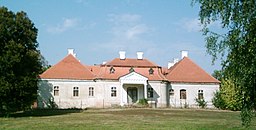Zseliz
| Želiezovce | ||
| Zselíz | ||
| Town | ||
|
||
| Country | Slovakia | |
|---|---|---|
| Region | Nitra | |
| District | Levice | |
| River | Hron | |
| Elevation | 137 m (449 ft) | |
| Coordinates | 48°02′55″N 18°39′37″E / 48.04861°N 18.66028°ECoordinates: 48°02′55″N 18°39′37″E / 48.04861°N 18.66028°E | |
| Area | 56.523 km2 (21.824 sq mi) | |
| Population | 7,486 (2005) | |
| Density | 132/km2 (342/sq mi) | |
| First mentioned | 1274 | |
| Mayor | Marin Andric | |
| Timezone | CET (UTC+1) | |
| - summer (DST) | CEST (UTC+2) | |
| Postal code | 937 01 | |
| Area code | +421-36 | |
| Car plate | LV | |
| Statistics: MOŠ/MIS | ||
| Website: www.zeliezovce.sk | ||
Želiezovce (Hungarian: Zselíz, (formerly) Zseliz, (til 1895) Zeliz, Zeléz, German: Zelis (rare)) is a town in Slovakia in the Nitra Region, in the Levice District, near the Hron river.
The territory of the settlement was inhabited as early as the Bronze Age, the Quadi period and the Great Moravian period. The town was first mentioned in 1274. It was heavily damaged at the end of World War II.
The town gave name to the archeological Želiezovce group (named after a find in Veľký Pesek, now part of the village Sikenica, which was part of Želiezovce in 1986-1992).
According to the 2001 census, the town had 7,522 inhabitants. 51.25% of inhabitants were Hungarians, 47.10% Slovaks, 0.55% Roma and 0.49% Czechs. The religious make-up was 61.27% Roman Catholics, 18.43% people with no religious affiliation, and 6.37% Lutherans.
The town is known for a former Neoclassical residence of Count Johann Karl Esterházy, where the Austrian composer Franz Schubert taught music to the Count's daughters Maria and Karoline in the summers of 1818 and 1824. Apart from a nice large park, there is another important building: the Schubert House or Owl Chateau (Slovak: Soví zámoček, Magyar: Baglyosház), where Franz Schubert stayed, and composed some of his works. Finally, the town features a Gothic Catholic church, severely damaged in 1945.
...
Wikipedia






